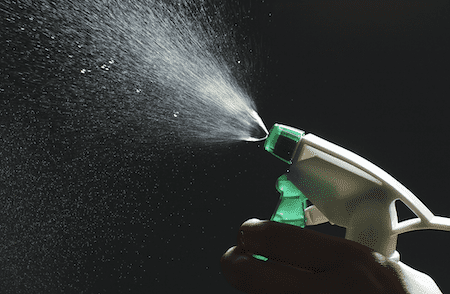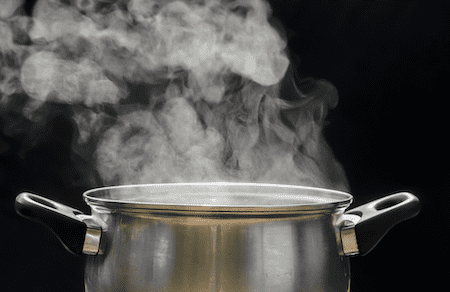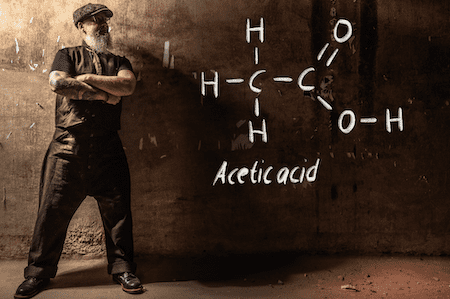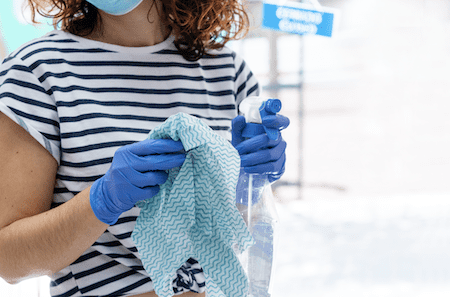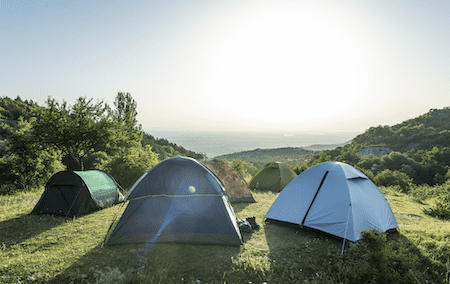Ever spent a rainy weekend or vacation tent camping? If yes, you probably used a tent that had seen a few seasons of backcountry use, perhaps with a year or two of storage thrown in there as well.
Then it’s easy to guess that you may have found the “moldy” smell in your tent to be a bit overwhelming at times.
The presence of mold on a tent is one of the grossest things you can find while camping. While it can make your experience miserable, it may also be the cause of a host of health problems.
That being said, let me show you how to clean a tent with mold in several different ways, so you’ll never have to compromise the outdoor fun.
How To Identify Mold In A Tent
There are a few ways to identify mold when you aren’t sure whether the tent has a mold problem. Mold may appear on your tent’s fabric as black, green, or even blue specks, while mildew appears as yellow, white, or gray.
Chances are, the mold developed on your tent fabric will look a bit fuzzy and smell like some old and damp, musty attic. It’s the result of the moisture trapped within the micro-cavities in your tent’s fabric.
The easiest way to avoid this is to rub a wet cloth on the spots and stains and wipe them away. Those mold and mildew spots should rub off, but if they don’t, you may have more severe mold problems.
The Four Best Methods To Clean A Tent With Mold
When your tent has severe mold problems, the first thing you need to know is that you must act fast enough; else, your tent gets doomed. Mold spread quicker than you might think, especially when the environment is in its favor.
Now, you might be tempted to oust mold off your tent right away by spraying it with bleach. After all, it’s got the power to kill mold fast.
However, if you need to clean mold from your tent, I’d suggest not choosing that path. The reason is that while bleach is excellent for hard, inert surfaces like your kitchen countertop, it can significantly damage and discolor the fabric of your tent.
Instead, you should try one of these four ways to clean your moldy tent.
Method 1: Try Spray-On Mold Treatment
Chemical treatments are beneficial in multiple ways.
They can:
- Eliminate mold and mildew growth
- Remove stains
- Kill the micro mold spores hiding on the tent
- Get rid of bacteria
- Take care of viruses
Due to these characteristics, they are excellent at handling mold problems. Most of these treatments come in spray bottles, resembling household cleaners.
Hence, you might want to keep one around the house or even bring one along on a camping trip, especially when it’s a long one in some damp area.
The tent needs to be fully assembled to carry out this treatment. Here are the steps to follow.
Step 1: Choose Your Product
It’s essential to choose a product that offers multiple benefits. If you’re going to kill mold, find a product that will prevent recurring mold growths, too.
Furthermore, you should look into the material the product might work best on – some work better on fabrics, others on non-porous materials.
Additionally, mold and mildew buildup on tent poles may require more treatments than one. However, cleaning aluminum poles is quite easy and fast than fiberglass ones, more here.
You can go for Concrobium Mold Control Spray to use on your tent’s fabric or other porous material and Mold Armor Mold and Mildew Killer for the poles.
The first one is also good at leaving a preventive barrier to battle future mold buildups. However, you shouldn’t spray the stuff in all areas of your tent as a prevention tactic; stick to focusing on those prone to mold and mildew.
Step 2: Spray-On The Mold
Either of the products you use must be let sit for a while after spraying. And afterward, you can wipe it away when it has had the time to sink into the tent material.
Step 3: Wipe The Residue Away
Different mold cleaners require varying procedures, but the two I mentioned above don’t require harsh scrubbing. They also don’t need rinsing after use.
Then, you’ll only need to clean up the mold residue with water and a cloth following the treatment. As always, though, the process depends on the product on hand.
Step 4: Let The Tent Dry
Once the treatment is over, let your tent dry naturally. You should leave it in the shade fully assembled.
Disassemble the tent only when the fabric is completely dry on all sides.
Method 2: Wash With Warm Water And Soap
The easiest way to remove the mold while camping is with soap and water. Also, it’s invaluable during emergencies when you have no other means of treatment to use.
It’s unlikely that you’ll kill every hidden mold spore with this method, but it will wash away any existing mold. Instead of soap, you could use a tent cleaning solution if you have one on hand.
Make sure you’re using a mild soap before adding it to warm water. Try to avoid chemical-packed soaps since you can’t be sure what chemicals might damage your tent.
It’s best to use a soft sponge for this task, but any rag will do. Simply start scrubbing away the mold stains with the rag or sponge dipped in water, then rinse the soap out and let the tent air dry.
Method 3: Try Home Remedies
There might be an emergency, and you are in no time to order a product, or maybe you prefer not to use chemicals at all, even those noncorrosive ones.
It’s alright. You can find quite a few effective remedies at home. Below are the three most effective, streamlined, universal mold and mildew removal methods.
Vinegar/White Vinegar
The intense acidity in vinegar makes it ideal for fighting mold. It doesn’t damage tent fabrics and can cut through bacteria easily.
Mix one-fourth a cup of vinegar or white vinegar with a cup of warm water and pour the mixture into a spray bottle.
Then spray it on the mold-affected areas and let it sit for a couple of minutes. Don’t rinse; just keep the tent standing and put it away after drying it well.
If you have a canvas tent, you’ll have to scrub it with the mixture, and a stiff bristle brush is ideal for this. It will also make your canvas tent waterproof.
Lemon Juice And Salt
If vinegar’s strong smell puts you off, you can use lemon and salt to get similar results. The method also shares a similar approach to the one above.
Pour a cup of salt-mixed lemon juice into a gallon of hot water. Then take some of the mixtures in a spray bottle and spray the moldy areas on your tent.
Let it sit well before scrubbing the fabric. When done, allow it to air dry, keeping it pitched.
Baking Soda
Baking soda paves another way to fight mold and mildew effectively. It makes the environment harsh for germs and bacteria, killing them immediately.
Add one-fourth a tablespoon of baking soda to a spray bottle containing hot water and shake thoroughly to dissolve.
Spray onto the mold and let it sit for a minute. Then take a stiff-bristle brush to scrub off the moldy spores. Be sure to be thorough yet gentle.
Next, rinse your tent with water before spraying it once more. Don’t rinse again after the final application; just let it air dry.
Method 4: Deep Clean
It may be necessary to deep clean your tent if mold buildup is beyond extensive. In this case, you need to wash the tent thoroughly.
Tents should be easy to wash by hand. It isn’t wise to wash them in a washing machine, for it can damage the seams and any available protecting coat.
Here’s how to deep clean a tent with mold.
- Use one of the above methods to clean your tent and remove the mold to the best of your ability.
- Be sure your tent is wholly unzipped and inside out before you soak it.
- Fill a bathtub or large sink with lukewarm water and add a tent cleaning solution like this one.
- Move your tent around in the water gently after you have immersed it.
- As recommended by your tent cleaning solution, let your tent soak as long as possible.
- Clean and empty your bath before filling it with lukewarm water.
- Once more, immerse your tent in the water and repeat the process until the tent is entirely suds-free.
How To Get Rid Of The Moldy Odor
Even when the tent is clean, the inside may still have a bad smell. Try not to spray a sweet-smelling air freshener since the scent will only mask the smell and get animals and insects attracted to it.
Instead, try an odor eliminator, like Revivex or Mirazyme, which contains microbes that consume the mold-causing bacteria.
These enzyme-based solutions are all-natural, and they’re good to use on other stuff as well (including stinky shoes).
Conclusion
Camping in a moldy tent is never the desired experience for anyone. And only a proper cleaning of the tent can reduce the likelihood of it happening.
Your tent is supposed to last for years, but it might not when it becomes moldy, as the mold can damage the fabric irreparably, making it useless over time.
But now that you have learned how to clean a tent with mold, you will have no qualms about treating it if need be.



